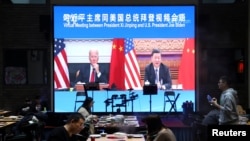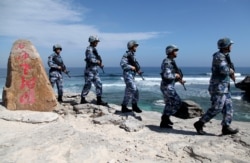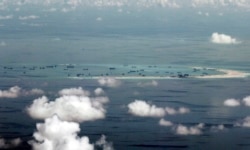On November 15, U.S. President Joe Biden and Chinese President Xi Jinping held a one-on-one virtual summit, their first such meeting since Biden took office in January.
Several issues for potential bilateral cooperation were on the agenda, including climate change, arms control and human rights.
One pressing item was the status of Taiwan.
Biden, who had earlier told reporters that Taiwan was “independent,” clarified that the United States continued to support the one-China policy, which recognizes the Chinese Communist Party as China’s government.
However, the United States does not endorse the One China Principle, which views Taiwan as an inalienable part of China.
Xi, for his part, said Taiwan’s attempts to get U.S. support for independence is “playing with fire.”
In October, China dispatched a record number of jets into the southwest portion of Taiwan’s air defense identification zone, prompting Taiwan’s foreign minister to say his country is ready for war.
Still, according to China Global Television Network (CGTN), Xi touted China’s peaceful intentions in speaking with Biden.
“Xi said the Chinese people have always loved and valued peace, adding that aggression or hegemony is not in the blood of the Chinese nation,” CGTN reported.
“Since the founding of the People's Republic, China has never started a single war or conflict, and has never taken one inch of land from other countries,” CGTN cited Xi as saying. “The country has no intention to sell its own development path around the world.”
It is false to claim that China has never started a war or taken an inch of land from other countries.
As Polygraph.info previously reported, the People’s Republic of China has invaded Vietnam and India. Tens of thousands of people were killed during its invasion of Vietnam in 1979.
Intermittent fighting continued until 1991, with China occupying Vietnamese territory.
In 1974, China seized the Vietnamese-controlled part of the Paracel Island chain, and captured six Spratly Island reefs from Vietnam in 1988. Both island chains are in the South China Sea.
Evidence has surfaced raising doubts about Beijing’s claims that it has maintained some form of dominion over the Paracel and Spratly Islands since antiquity.
In 1962, three years after China invaded Tibet, China also instigated a war with India along their disputed Himalayan border.
During that conflict, China consolidated control over Aksai Chin — the eastern part of the Kashmir region, which India continues to claim.
Beijing incited another Himalayan border war with India in 1967, with hostilities recommencing last year after decades of relative calm.
China has built settlements in territory claimed by India, a move that some analysts say is changing the status quo along the Line of Actual Control separating Chinese from Indian territory.
As Polygraph.info previously noted, the era of Tibetan independence from 1911 to 1951 was ended after China’s People's Liberation Army invaded Tibet in October 1950.
More recently, China has made sweeping territorial claims in the South China Sea.
In 2009, China claimed it had “indisputable sovereignty over the islands in the South China Sea and the adjacent waters” and “sovereign rights and jurisdiction over the relevant waters as well as the seabed and subsoil thereof.”
In 2016, an international tribunal in The Hague partially rebuked those claims. However, Beijing has ignored that ruling.
China has not only seized islands and reefs from Vietnam, but also captured the Scarborough Shoal, some 137 miles east of the Philippines’ island of Luzon.
In 1994, China seized Mischief Reef, an atoll 250 kilometers west of the Philippines' Palwan Island. China also maintains an illegal blockade of the Second Thomas Shoal, near Mischief Reef.
On November 16, China’s coast guard blocked a resupply mission to a small Philippines military outpost on Second Thomas Shoal, which falls within the Philippines Exclusive Economic Zone (EEC).
In 2016, The Hague tribunal ruled that Mischief Reef and Second Thomas Shoal are actually part of the Philippines’ continental shelf.
Still, Beijing has militarized Mischief Reef and built an artificial island on it.
China has also had dozens of “Maritime Militia” ships “moored, anchored and stationary at Julian Felipe Reef,” in the Spratly Islands, which also fall within the Philippines EEZ, Radio Free Asia reported in March. (Radio Free Asia is a sister news organization of the Voice of America.)
That fits into broader Chinese efforts to maintain dominance in the South China Sea through building military outposts on the Paracel and Spratly islands, and deploying anti-ship cruise missiles and long-range surface-to-air missiles.
Japan has accused China of stepping up efforts to assert its dominance in the East China Sea, particularly around the disputed Senkaku/Diaoyu Islands.
On November 13, Japan's new foreign minister, Yoshimasa Hayashi, said U.S. Secretary of State Antony Blinken had assured him that the U.S. commitment to “defending Japan,” including the Senkaku Islands, was "unwavering,” Reuters reported.







